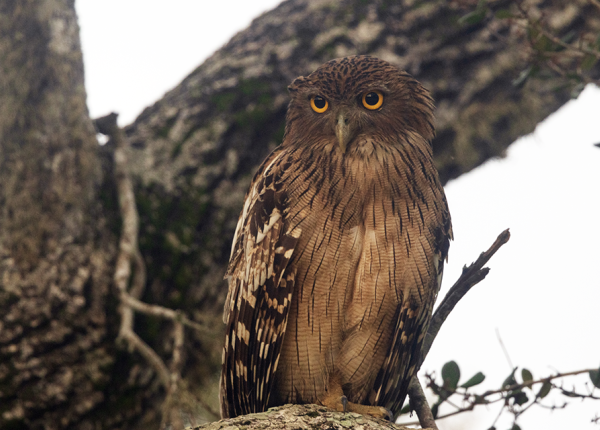Did You Know?
- There are four known subspecies of Brown Fish-owl
- This species is both diurnal and nocturnal
How The Peregrine Fund is Helping
Though The Peregrine Fund does not work directly with Brown Fish-owls, our efforts in scientific research, habitat conservation, education, and community development help conserve birds of prey around the world. We also supply literature to researchers from our avian research library, which helps scientists around the world gather and share important information on raptor conservation. And, finally, our support of the Global Raptor Information Network gives raptor researchers tools to more efficiently conduct their own studies while contributing to a global program. It also provides citizen scientists a way to participate in raptor science and conservation.
Where They Live
Found in the Middle East and in much of south and southeast Asia, the Brown Fish-owl makes its home in a wide variety of habitats from deciduous, and semi-deciduous forests, to woodlands, ravines, and even tree plantations and groves. This owl is almost always found close to a water body.
What They Do
This owl is active at nearly all hours of the day and night. True to its name, it spends a lot of its time fishing for food. It is a beautiful owl with buffy feathers around its facial disc, and a lovely medley of browns, blacks, and creamy beiges all over its body. It has striking bright yellow irises. Like the Eurasian Eagle-owl it has feathery ear tufts, which aren't ears at all, but rather feathers that look like the ears of some mammals. These protruding feathers can aide in communication and camouflage.
Why They Need Our Help
The Brown Fish-owl is categorized as a species of Least Concern. However, that doesn't mean it isn't facing several threats. It is sometimes shot by fish farmers for consuming their fish. Loss of habitat, such as draining of lakes or swamps, and pollution in waterways are all threats this species faces. There is still so much that scientists need to learn about this beautiful owl in order to help ensure it continues to thrive throughout its range.
What They Eat
Given its name, it is probably clear that the Brown Fish-owl feeds on fish. It also hunts amphibians, crabs, crayfish, reptiles, insects, small mammals, and birds. It has also been known to feed once in a while on carrion, including on dead crocodiles. When on the search for food, the owl will often sit on a perch overlooking water. When it spots something, it will drop down, drag its legs in the water, and grab prey with its strong feet. It might also wade into shallow water in search of food.
Nests, Eggs, and Young
Like most other owls, the Brown Fish-owl doesn't build its own nest, but rather lays its eggs in tree hollows or cavities. It sometimes will lay eggs in abandoned nests built by other raptors, or on a ledge, stream bank, or abandoned buildings. These owls most often choose to nest near water.
The female will generally lay between 1-3 eggs, which she will incubate and care for for the next 34–38 days. Once the owlets hatch, they will grow quickly! After only 45–50 days they will be ready to fly from the nest for the first time!
References:
BirdLife International. 2016. Ketupa zeylonensis. The IUCN Red List of Threatened Species 2016: e.T22689012A90010491. https://dx.doi.org/10.2305/IUCN.UK.2016-3.RLTS.T22689012A90010491.en. Accessed on 20 December 2021.
Holt, D. W., R. Berkley, C. Deppe, P. L. Enríquez, J. L. Petersen, J. L. Rangel Salazar, K. P. Segars, K. L. Wood, G. M. Kirwan, and J. S. Marks (2020). Brown Fish-Owl (Ketupa zeylonensis), version 1.0. In Birds of the World (J. del Hoyo, A. Elliott, J. Sargatal, D. A. Christie, and E. de Juana, Editors). Cornell Lab of Ornithology, Ithaca, NY, USA. https://doi.org/10.2173/bow.brfowl1.01









